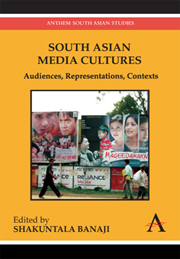Book contents
- Frontmatter
- Contents
- List of Illustrations
- 1 Introduction
- Part One Elaborating Audiences: Meaning, Use and Social Context
- Part Two Telling Texts: Media Discourse, Identity and Politics
- Part Three Alternative Producers: The Articulation of (New) Media, Politics and Civic Participation
- 11 Through the Lens of a ‘Branded Criminal’: The Politics of Marginal Cinema in India
- 12 Pakistani Students' Uses of New Media to Construct a Narrative of Dissent
- 13 Expanding the Art of the Possible: Leveraging Citizen Journalism and User Generated Content (USG) for Peace in Sri Lanka
- 14 Conclusion
- List of Contributors
12 - Pakistani Students' Uses of New Media to Construct a Narrative of Dissent
from Part Three - Alternative Producers: The Articulation of (New) Media, Politics and Civic Participation
Published online by Cambridge University Press: 05 March 2012
- Frontmatter
- Contents
- List of Illustrations
- 1 Introduction
- Part One Elaborating Audiences: Meaning, Use and Social Context
- Part Two Telling Texts: Media Discourse, Identity and Politics
- Part Three Alternative Producers: The Articulation of (New) Media, Politics and Civic Participation
- 11 Through the Lens of a ‘Branded Criminal’: The Politics of Marginal Cinema in India
- 12 Pakistani Students' Uses of New Media to Construct a Narrative of Dissent
- 13 Expanding the Art of the Possible: Leveraging Citizen Journalism and User Generated Content (USG) for Peace in Sri Lanka
- 14 Conclusion
- List of Contributors
Summary
Introduction
4 November 2007 was witness to a very unusual sight in Pakistan: hundreds of students marching in a political protest. The protest was launched at a small, elite university, LUMS, and the students were protesting the arrest of faculty members in the aftermath of the emergency declared in Pakistan on 3 November. The sight of students protesting was to become increasingly familiar as the weeks of emergency dragged on. Initially, the movement seemed to be composed of a number of independent and unrelated individuals. However, over time, certain foci of attention emerged and eventually led to the formation of SACs, student action committees, at different colleges and universities.
These SACs worked in conjunction and individually on political agendas that continued to evolve over time. The students were faced with many challenges: the authoritarian response of the government to any public dissent; the mass-media blackout imposed by the regime; a need for anonymity; and the need to organise rapidly. The most logical solution turned out to be the personal new media these students had access to, particularly mobile phones and the World Wide Web. They used these media to piece together a discourse that quickly found its way into local media discussions as well as the international media.
The theoretical framework for this chapter will be drawn from concepts of youth political activism, particularly in urban areas, and the impacts of new media on civic engagement amongst young people.
- Type
- Chapter
- Information
- South Asian Media CulturesAudiences, Representations, Contexts, pp. 221 - 234Publisher: Anthem PressPrint publication year: 2010

